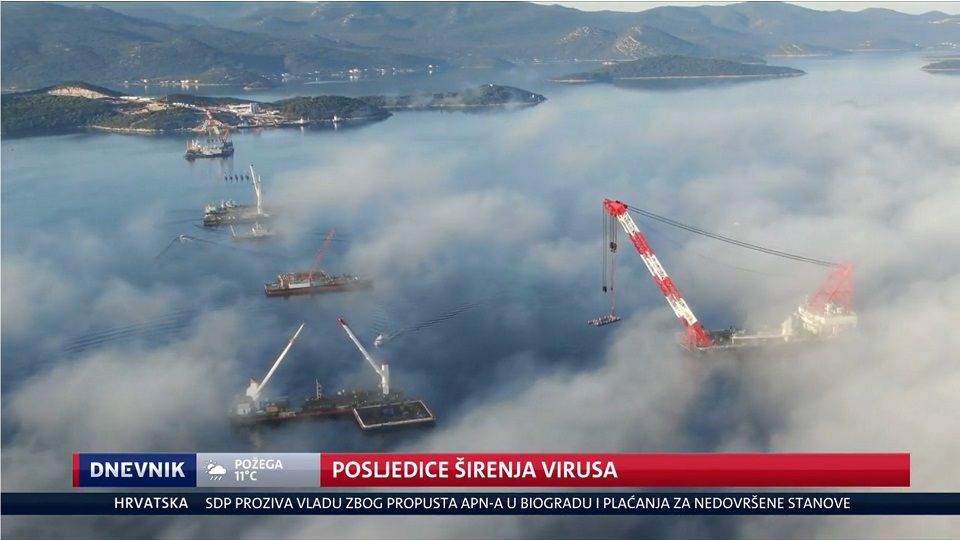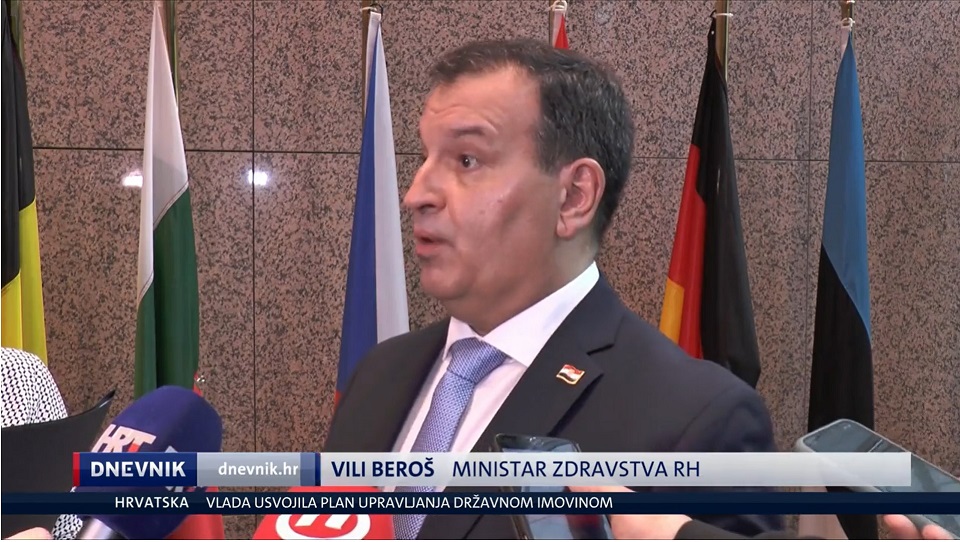Bridge Designer Says Pelješac Bridge His Biggest Challenge Yet
ZAGREB, 26 July 2022 - Slovenian engineer Marjan Pipenbaher, who designed Pelješac Bridge in southern Croatia, said ahead of the bridge's opening on Tuesday that this was the biggest challenge in his career, which includes more than 200 similar projects.
"Pelješac Bridge is among Europe's five largest bridges spanning sea bays that have been built in this century and ranks among the world's finest," Pipenbaher told Slovenian Radio, adding that it was a challenge to design it because it is situated in a wind-swept and earthquake-prone area.
He said that the bridge is important not only for Croatia, because it connects its southernmost part with the rest of the country, but also for Europe at large. "After all, it is one of the conditions for Croatia to join the Schengen area."
Pelješac Bridge was built by China Road and Bridge Corporation, and Pipenbaher said that no one was killed during the construction. "There were only two fairly serious accidents, which should also be noted."
For more news about Croatia, click here.
More Than 1000 Workers Currently at Peljesac Bridge and Access Roads
September the 20th, 2021 - Works at the Peljesac bridge site, Croatia's most important stragetic project, are going at full speed as 1000 workers are busy finishing things off and dealing with the access roads.
As Poslovni Dnevnik writes, the Peljesac bridge and access road construction site is as busy as ever. More than 1,000 workers are currently employed on this largest construction site in the Republic of Croatia. More precisely, according to Hrvatske ceste (Croatian roads), Peljesac bridge and its access roads are being built by a total of 1,098 workers at this moment in time, and when technical and support staff are added, there will be a total of 1,277 people on the ground on site and in the nearby Mali Ston Bay, as reported by Vecernji list.
On the access roads themselves, (more precisely on the Duboka - Sparagovici section) work was being carried out on the wide excavation of the route all the way to the Kamenica tunnel. Between the Dumanja Jaruga bridges (I and II) and the Debeli brijeg tunnel, work is currently being done on the construction of an external drainage system, and on the Dumanja Jaruga I bridge, the construction of columns as well as the first segment of the span structure on pillar S1 has now been completed.
On the Dumanja Jaruga II bridge, two segments of the span structure were constructed with the help of a cage, and the foundation was concreted on the S1 pillar. At the Zaradeza junction, excavation works are underway for the future Zaradeza traffic control centre, where walls, horizontal and vertical circles are currently being built. In the Debeli Brijeg tunnel (1424 metres in length), which was breached back in December, works on the construction of waterproofing, reprofiling and sub-concrete are continuing. A total of 296 workers are engaged on this section of the access roads, of which 61 are technical staff.
On the Ston bypass and the Sparagovici - Papratno - Doli road section, among other things, all segments have been drawn up on the Prapratno viaduct. Works on the steel structure and AKZ are also now in progress. The excavation of the Polakovica tunnel (1242 metres) has been completed, and a wide full profile excavation is now being carried out. The Supava tunnel (1290 metres) also now breaks through on two sides (and entrance and an exit).
On the Ston bridge (485 metres), reinforced concrete works on the head of the S5 pillar have now been completed. Reinforced concrete works on the construction of the pillar of the S3 pillar are in progress. The reinforced concrete foundation of the S4 staircase has been completed and reinforced concrete works on the construction of the pillar of the S4 staircase are in progress. Works on the head of the pillar of the S2 pillar and reinforced concrete works on the abutments of the Ston U1 and U7 bridges are in progress and the second phase of the wall and wings of the U7 abutment has been completed. A total of 330 workers are engaged in various jobs on the Peljesac bridge construction site, along with 33 members of the technical and administrative staff.
For more, make sure to check our our dedicated lifestyle section.
Coronavirus Shuts Down Chinese Factory Supplying Croatia Peljesac Bridge
The Pelješki most (Pelješac Bridge) might be the first victim of the coronavirus in Croatia. The Chinese factory which is building the steel structures for the bridge is temporarily closing. Fortunately, the virus has not yet reached Croatia.

Coronavirus Closes Chinese Steel Structure Factory
The virus has paralyzed China, and that now includes the factory where steel structures are being made for the Pelješki most, according to Vibor Vlainić/Dnevnik on February 13, 2020. This does not mean that work on the bridge will cease in Croatia, but the question remains what will happen when the time comes to install these new structures.
Will the steel structures arrive in Croatia on time? Hrvatske autoceste (Croatian Roads) indicated that the contractor has not asked for an extension. The bridge is scheduled to open on July 31, 2021.
"The contractor (China Road and Bridge Corporation) has taken all the necessary measures, first and foremost, to prevent a potential (coronavirus) health threat to the construction site. They have implemented protective measures at the site and these measures are being enacted according to clear guidelines," HAC reported.
However, Hrvatske autoceste will not be able to send supervisory engineers to the factory in China due to the rapid spread of the infection in that country.

EU Heath Ministers Meeting: Croatia Will Not Close Borders
Due to the danger of the virus, a meeting of health ministers of all EU member states was held in Brussels at the invitation of the Croatian Presidency.
Although several countries have imposed entry restrictions on passengers who have been in China; Croatia has not yet followed suit. Two Chinese tourists have reported to Croatian hospitals with upper respiratory infections this past month: one in Pula and one in Split. Both tested negative for the coronavirus.
"We are not claiming to be absolutely certain (in our approach) but are taking caution. Everyone is asking about closing the Croatian borders, but that is not presently a realistic option. If the situation escalates; of course, we will consider additional factors. That is the most constructive approach for this situation, because emergency situations require extraordinary measures," explained Health Minister Vili Beroš.
At the meeting, several countries requested that each passenger coming from a country with confirmed coronavirus cases list each person with whom they have been in contact upon their entry to the European Union. But they eventually arrived at a compromise.
"It is certain that any person would be able to list all the contacts they have had, but it is expected that someone would answer whether they have had contact with people who have showed signs of illness, cough or fever or have been ill," Beroš added.
Daily updates on the coronavirus can be found here. An archive of Total Croatia News articles on the coronavirus can be accessed here.


